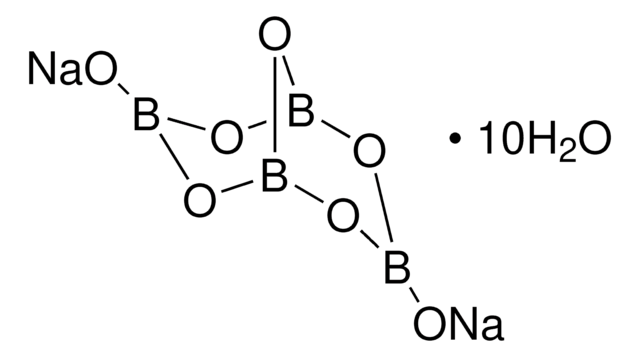Kluczowe dokumenty
31146
Boric acid
puriss. p.a., ACS reagent, reag. ISO, reag. Ph. Eur., buffer substance, ≥99.8%
About This Item
Polecane produkty
klasa czystości
ACS reagent
puriss. p.a.
agency
USP/NF
reag. ISO
reag. Ph. Eur.
ciśnienie pary
2.6 mmHg ( 20 °C)
Próba
≥99.8%
Formularz
powder or crystals
zanieczyszczenia
≤0.005% insoluble in methanol
≤0.05% with methanol-HCl non-volat. matter
pH
3.6-4.0 (20 °C, 4%)
mp
160 °C (dec.) (lit.)
rozpuszczalność
water: soluble
gęstość
1.440 g/cm3
ślady anionów
chloride (Cl-): ≤3 mg/kg
phosphate (PO43-): ≤5 mg/kg
sulfate (SO42-): ≤5 mg/kg
ślady kationów
As: ≤5 mg/kg
Ca: ≤10 mg/kg
Cd: ≤5 mg/kg
Cu: ≤5 mg/kg
Fe: ≤1 mg/kg
Mg: ≤5 mg/kg
Pb: ≤5 mg/kg
Zn: ≤5 mg/kg
ciąg SMILES
OB(O)O
InChI
1S/BH3O3/c2-1(3)4/h2-4H
Klucz InChI
KGBXLFKZBHKPEV-UHFFFAOYSA-N
Szukasz podobnych produktów? Odwiedź Przewodnik dotyczący porównywania produktów
Opis ogólny
Zastosowanie
Hasło ostrzegawcze
Danger
Zwroty wskazujące rodzaj zagrożenia
Zwroty wskazujące środki ostrożności
Klasyfikacja zagrożeń
Repr. 1B
Kod klasy składowania
6.1C - Combustible acute toxic Cat.3 / toxic compounds or compounds which causing chronic effects
Klasa zagrożenia wodnego (WGK)
WGK 1
Temperatura zapłonu (°F)
Not applicable
Temperatura zapłonu (°C)
Not applicable
Wykazy regulacyjne
Wykazy regulacyjne dotyczą głównie produktów chemicznych. Można w nich podawać ograniczoną liczbę informacji na temat produktów niechemicznych. Brak wpisu oznacza, że żaden ze składników nie znajduje się w wykazie. Użytkownik odpowiada za zagwarantowanie bezpiecznego i zgodnego z prawem stosowania produktu.
EU REACH SVHC Candidate List
EU REACH Annex XVII (Restriction List)
Wybierz jedną z najnowszych wersji:
Masz już ten produkt?
Dokumenty związane z niedawno zakupionymi produktami zostały zamieszczone w Bibliotece dokumentów.
Klienci oglądali również te produkty
Nasz zespół naukowców ma doświadczenie we wszystkich obszarach badań, w tym w naukach przyrodniczych, materiałoznawstwie, syntezie chemicznej, chromatografii, analityce i wielu innych dziedzinach.
Skontaktuj się z zespołem ds. pomocy technicznej



